Effective Business Communicative Writing: Guidelines and Examples
VerifiedAdded on 2022/09/09
|7
|1376
|11
Report
AI Summary
This report provides a comprehensive overview of business communicative writing, covering essential formats such as emails, memos, business letters (routine, good news, and bad news), persuasive letters, informal reports, and formal reports. The report emphasizes the importance of planning, conciseness, and sensitivity in business communication. It offers guidelines for each format, including examples and advice on tone, content, and structure. The report also addresses common grammatical errors and provides a reference list of relevant sources. This resource is designed to help individuals improve their business writing skills and communicate effectively in professional settings. The report also highlights best practices for writing in different business contexts, ensuring clarity and professionalism. The report offers practical examples and advice to enhance the reader's ability to convey information effectively in the workplace.
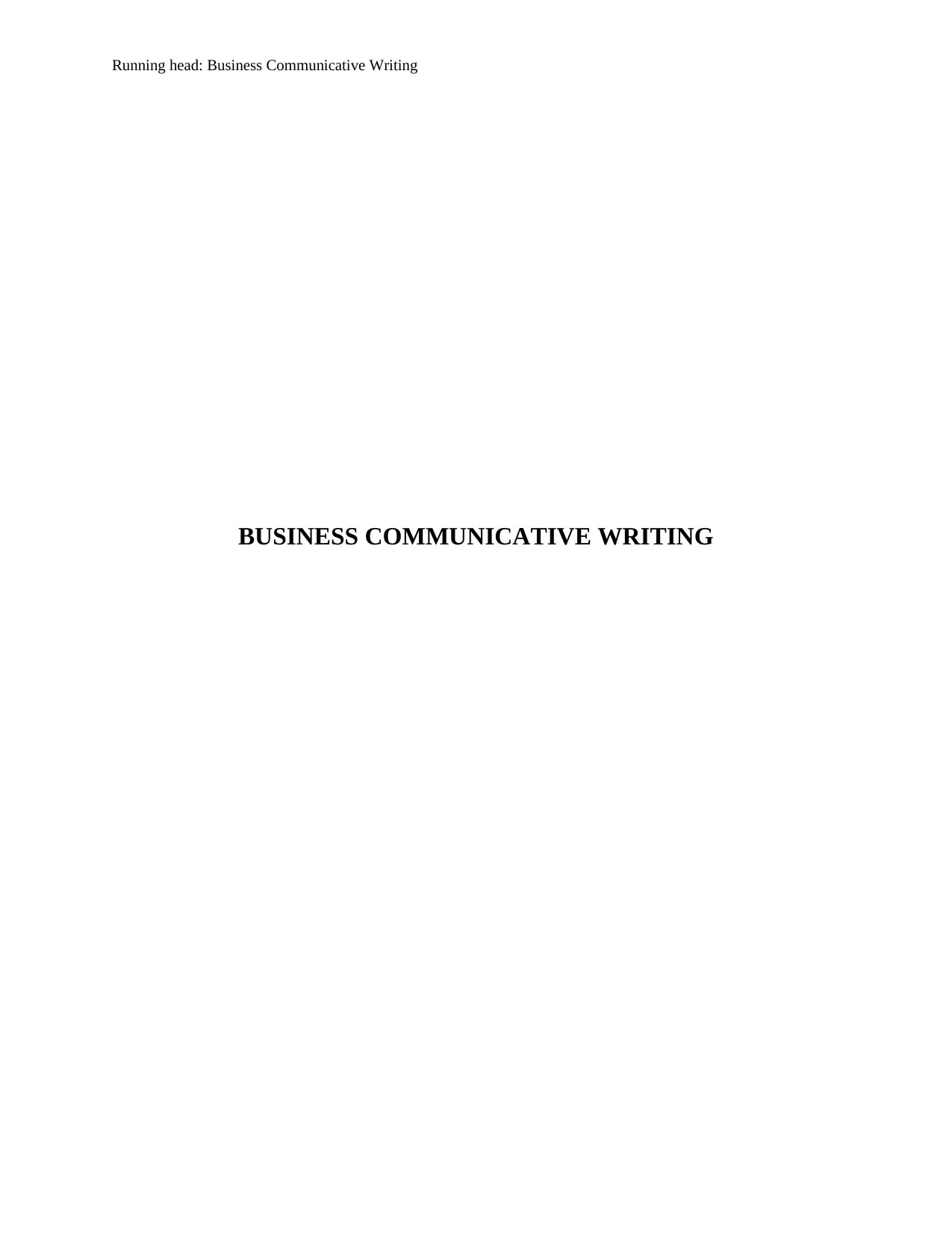
Running head: Business Communicative Writing
BUSINESS COMMUNICATIVE WRITING
BUSINESS COMMUNICATIVE WRITING
Paraphrase This Document
Need a fresh take? Get an instant paraphrase of this document with our AI Paraphraser
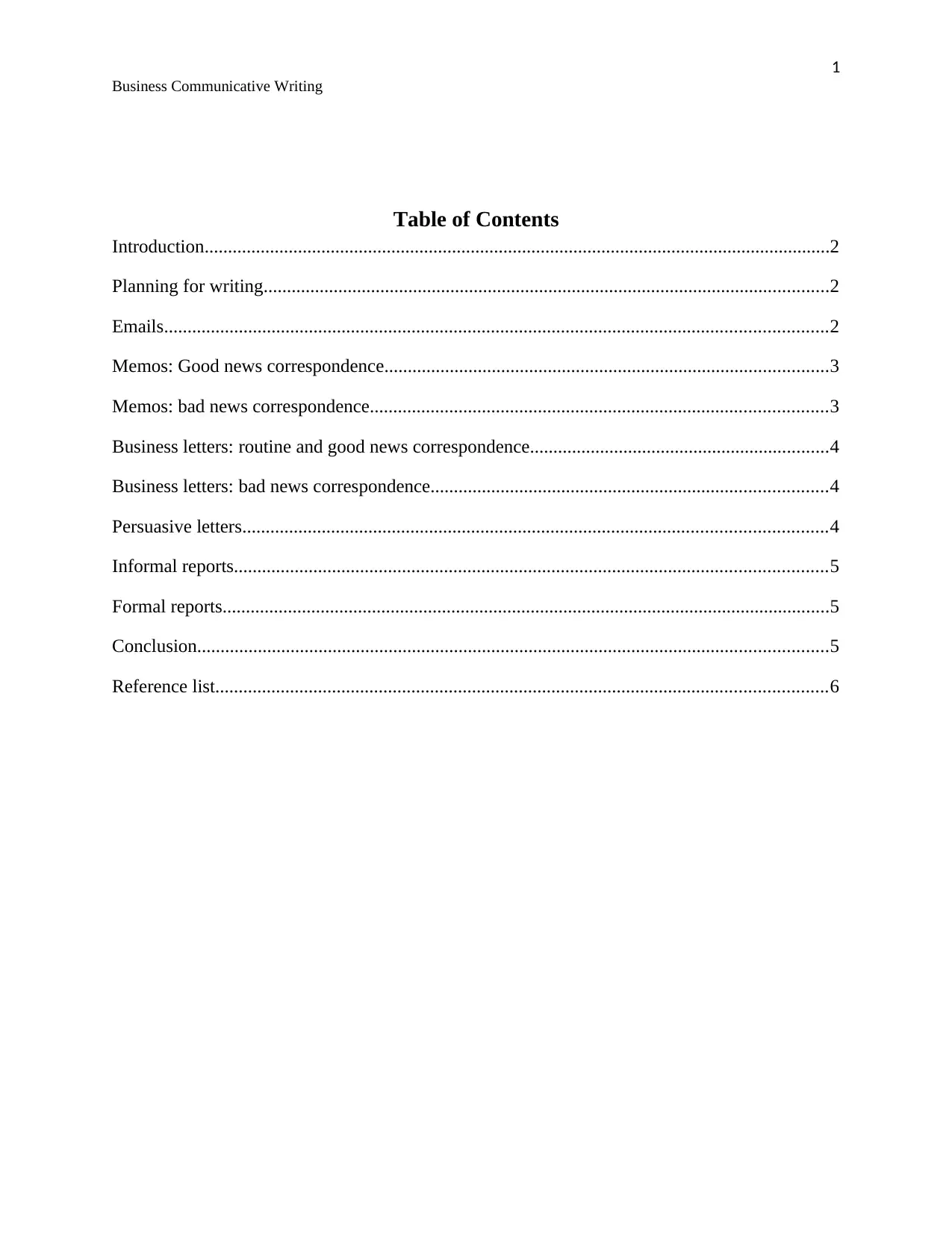
1
Business Communicative Writing
Table of Contents
Introduction......................................................................................................................................2
Planning for writing.........................................................................................................................2
Emails..............................................................................................................................................2
Memos: Good news correspondence...............................................................................................3
Memos: bad news correspondence..................................................................................................3
Business letters: routine and good news correspondence................................................................4
Business letters: bad news correspondence.....................................................................................4
Persuasive letters.............................................................................................................................4
Informal reports...............................................................................................................................5
Formal reports..................................................................................................................................5
Conclusion.......................................................................................................................................5
Reference list...................................................................................................................................6
Business Communicative Writing
Table of Contents
Introduction......................................................................................................................................2
Planning for writing.........................................................................................................................2
Emails..............................................................................................................................................2
Memos: Good news correspondence...............................................................................................3
Memos: bad news correspondence..................................................................................................3
Business letters: routine and good news correspondence................................................................4
Business letters: bad news correspondence.....................................................................................4
Persuasive letters.............................................................................................................................4
Informal reports...............................................................................................................................5
Formal reports..................................................................................................................................5
Conclusion.......................................................................................................................................5
Reference list...................................................................................................................................6
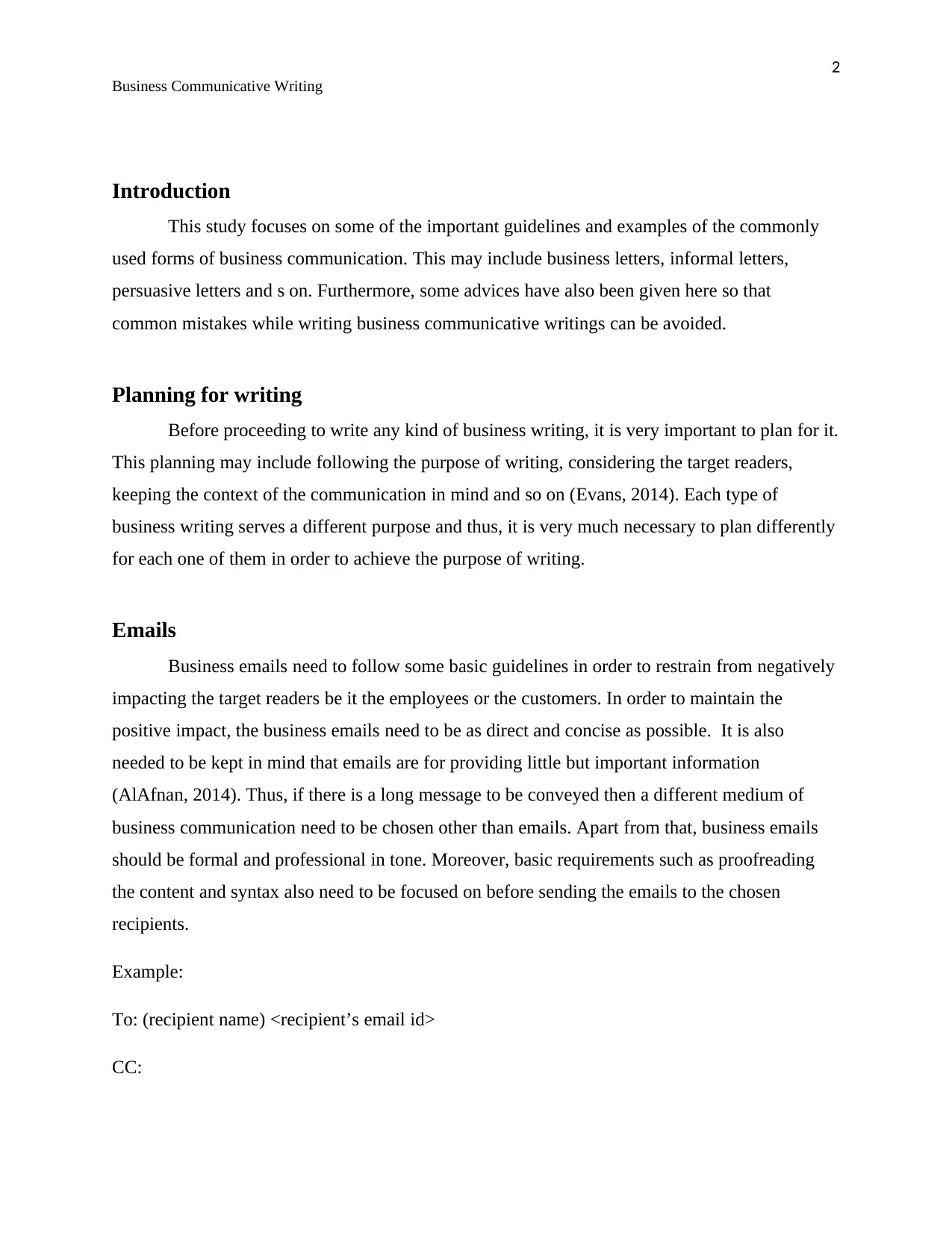
2
Business Communicative Writing
Introduction
This study focuses on some of the important guidelines and examples of the commonly
used forms of business communication. This may include business letters, informal letters,
persuasive letters and s on. Furthermore, some advices have also been given here so that
common mistakes while writing business communicative writings can be avoided.
Planning for writing
Before proceeding to write any kind of business writing, it is very important to plan for it.
This planning may include following the purpose of writing, considering the target readers,
keeping the context of the communication in mind and so on (Evans, 2014). Each type of
business writing serves a different purpose and thus, it is very much necessary to plan differently
for each one of them in order to achieve the purpose of writing.
Emails
Business emails need to follow some basic guidelines in order to restrain from negatively
impacting the target readers be it the employees or the customers. In order to maintain the
positive impact, the business emails need to be as direct and concise as possible. It is also
needed to be kept in mind that emails are for providing little but important information
(AlAfnan, 2014). Thus, if there is a long message to be conveyed then a different medium of
business communication need to be chosen other than emails. Apart from that, business emails
should be formal and professional in tone. Moreover, basic requirements such as proofreading
the content and syntax also need to be focused on before sending the emails to the chosen
recipients.
Example:
To: (recipient name) <recipient’s email id>
CC:
Business Communicative Writing
Introduction
This study focuses on some of the important guidelines and examples of the commonly
used forms of business communication. This may include business letters, informal letters,
persuasive letters and s on. Furthermore, some advices have also been given here so that
common mistakes while writing business communicative writings can be avoided.
Planning for writing
Before proceeding to write any kind of business writing, it is very important to plan for it.
This planning may include following the purpose of writing, considering the target readers,
keeping the context of the communication in mind and so on (Evans, 2014). Each type of
business writing serves a different purpose and thus, it is very much necessary to plan differently
for each one of them in order to achieve the purpose of writing.
Emails
Business emails need to follow some basic guidelines in order to restrain from negatively
impacting the target readers be it the employees or the customers. In order to maintain the
positive impact, the business emails need to be as direct and concise as possible. It is also
needed to be kept in mind that emails are for providing little but important information
(AlAfnan, 2014). Thus, if there is a long message to be conveyed then a different medium of
business communication need to be chosen other than emails. Apart from that, business emails
should be formal and professional in tone. Moreover, basic requirements such as proofreading
the content and syntax also need to be focused on before sending the emails to the chosen
recipients.
Example:
To: (recipient name) <recipient’s email id>
CC:
⊘ This is a preview!⊘
Do you want full access?
Subscribe today to unlock all pages.

Trusted by 1+ million students worldwide
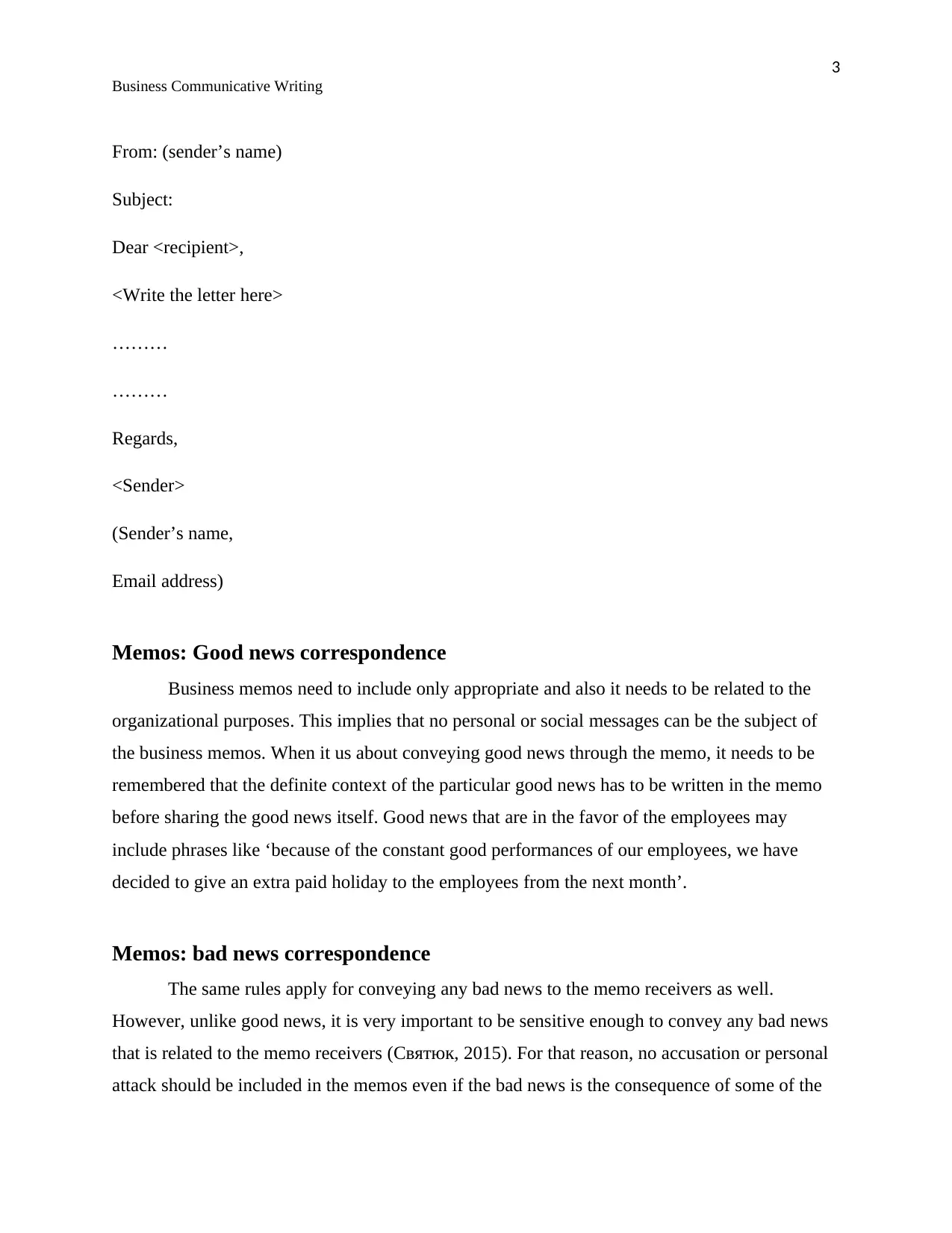
3
Business Communicative Writing
From: (sender’s name)
Subject:
Dear <recipient>,
<Write the letter here>
………
………
Regards,
<Sender>
(Sender’s name,
Email address)
Memos: Good news correspondence
Business memos need to include only appropriate and also it needs to be related to the
organizational purposes. This implies that no personal or social messages can be the subject of
the business memos. When it us about conveying good news through the memo, it needs to be
remembered that the definite context of the particular good news has to be written in the memo
before sharing the good news itself. Good news that are in the favor of the employees may
include phrases like ‘because of the constant good performances of our employees, we have
decided to give an extra paid holiday to the employees from the next month’.
Memos: bad news correspondence
The same rules apply for conveying any bad news to the memo receivers as well.
However, unlike good news, it is very important to be sensitive enough to convey any bad news
that is related to the memo receivers (Святюк, 2015). For that reason, no accusation or personal
attack should be included in the memos even if the bad news is the consequence of some of the
Business Communicative Writing
From: (sender’s name)
Subject:
Dear <recipient>,
<Write the letter here>
………
………
Regards,
<Sender>
(Sender’s name,
Email address)
Memos: Good news correspondence
Business memos need to include only appropriate and also it needs to be related to the
organizational purposes. This implies that no personal or social messages can be the subject of
the business memos. When it us about conveying good news through the memo, it needs to be
remembered that the definite context of the particular good news has to be written in the memo
before sharing the good news itself. Good news that are in the favor of the employees may
include phrases like ‘because of the constant good performances of our employees, we have
decided to give an extra paid holiday to the employees from the next month’.
Memos: bad news correspondence
The same rules apply for conveying any bad news to the memo receivers as well.
However, unlike good news, it is very important to be sensitive enough to convey any bad news
that is related to the memo receivers (Святюк, 2015). For that reason, no accusation or personal
attack should be included in the memos even if the bad news is the consequence of some of the
Paraphrase This Document
Need a fresh take? Get an instant paraphrase of this document with our AI Paraphraser
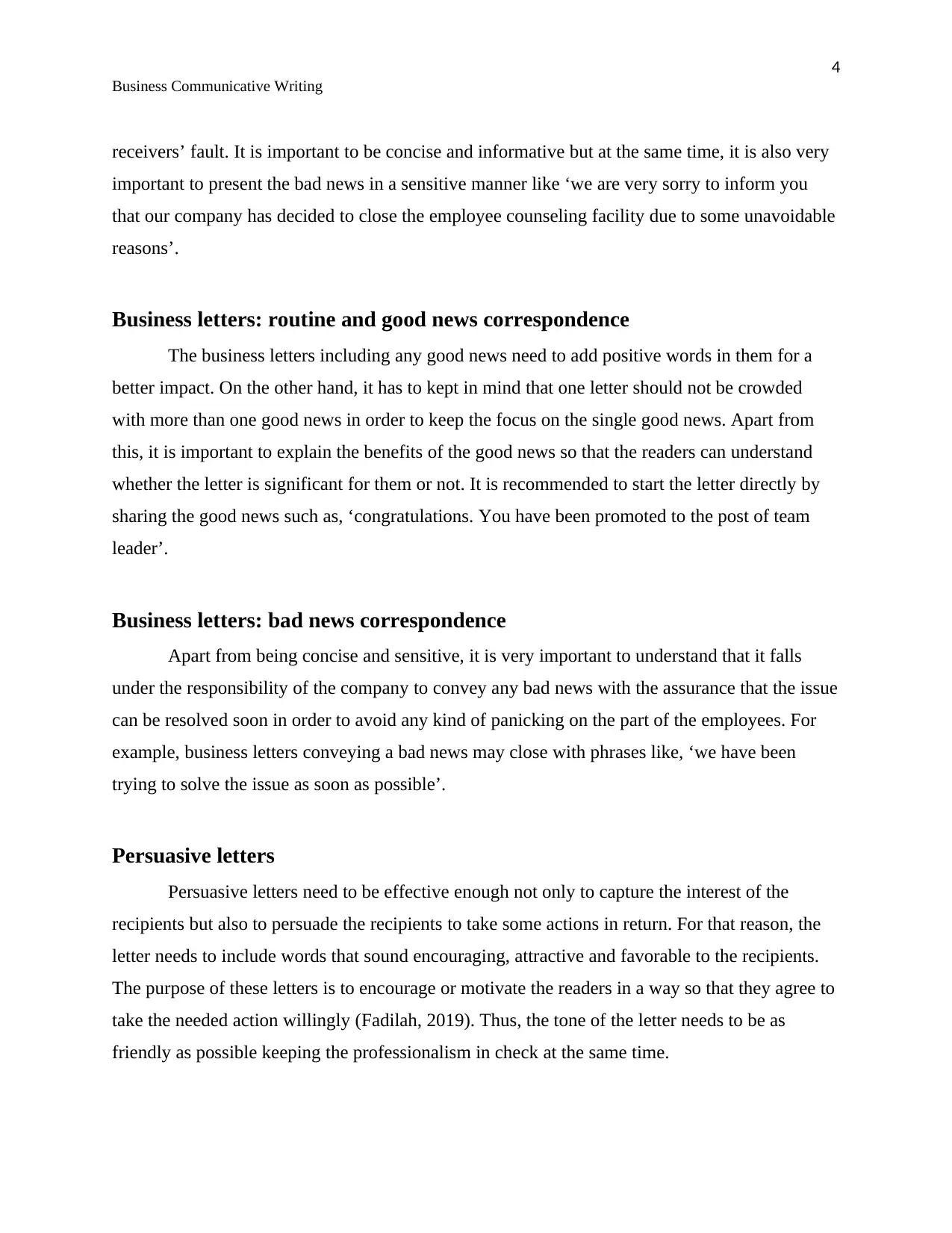
4
Business Communicative Writing
receivers’ fault. It is important to be concise and informative but at the same time, it is also very
important to present the bad news in a sensitive manner like ‘we are very sorry to inform you
that our company has decided to close the employee counseling facility due to some unavoidable
reasons’.
Business letters: routine and good news correspondence
The business letters including any good news need to add positive words in them for a
better impact. On the other hand, it has to kept in mind that one letter should not be crowded
with more than one good news in order to keep the focus on the single good news. Apart from
this, it is important to explain the benefits of the good news so that the readers can understand
whether the letter is significant for them or not. It is recommended to start the letter directly by
sharing the good news such as, ‘congratulations. You have been promoted to the post of team
leader’.
Business letters: bad news correspondence
Apart from being concise and sensitive, it is very important to understand that it falls
under the responsibility of the company to convey any bad news with the assurance that the issue
can be resolved soon in order to avoid any kind of panicking on the part of the employees. For
example, business letters conveying a bad news may close with phrases like, ‘we have been
trying to solve the issue as soon as possible’.
Persuasive letters
Persuasive letters need to be effective enough not only to capture the interest of the
recipients but also to persuade the recipients to take some actions in return. For that reason, the
letter needs to include words that sound encouraging, attractive and favorable to the recipients.
The purpose of these letters is to encourage or motivate the readers in a way so that they agree to
take the needed action willingly (Fadilah, 2019). Thus, the tone of the letter needs to be as
friendly as possible keeping the professionalism in check at the same time.
Business Communicative Writing
receivers’ fault. It is important to be concise and informative but at the same time, it is also very
important to present the bad news in a sensitive manner like ‘we are very sorry to inform you
that our company has decided to close the employee counseling facility due to some unavoidable
reasons’.
Business letters: routine and good news correspondence
The business letters including any good news need to add positive words in them for a
better impact. On the other hand, it has to kept in mind that one letter should not be crowded
with more than one good news in order to keep the focus on the single good news. Apart from
this, it is important to explain the benefits of the good news so that the readers can understand
whether the letter is significant for them or not. It is recommended to start the letter directly by
sharing the good news such as, ‘congratulations. You have been promoted to the post of team
leader’.
Business letters: bad news correspondence
Apart from being concise and sensitive, it is very important to understand that it falls
under the responsibility of the company to convey any bad news with the assurance that the issue
can be resolved soon in order to avoid any kind of panicking on the part of the employees. For
example, business letters conveying a bad news may close with phrases like, ‘we have been
trying to solve the issue as soon as possible’.
Persuasive letters
Persuasive letters need to be effective enough not only to capture the interest of the
recipients but also to persuade the recipients to take some actions in return. For that reason, the
letter needs to include words that sound encouraging, attractive and favorable to the recipients.
The purpose of these letters is to encourage or motivate the readers in a way so that they agree to
take the needed action willingly (Fadilah, 2019). Thus, the tone of the letter needs to be as
friendly as possible keeping the professionalism in check at the same time.
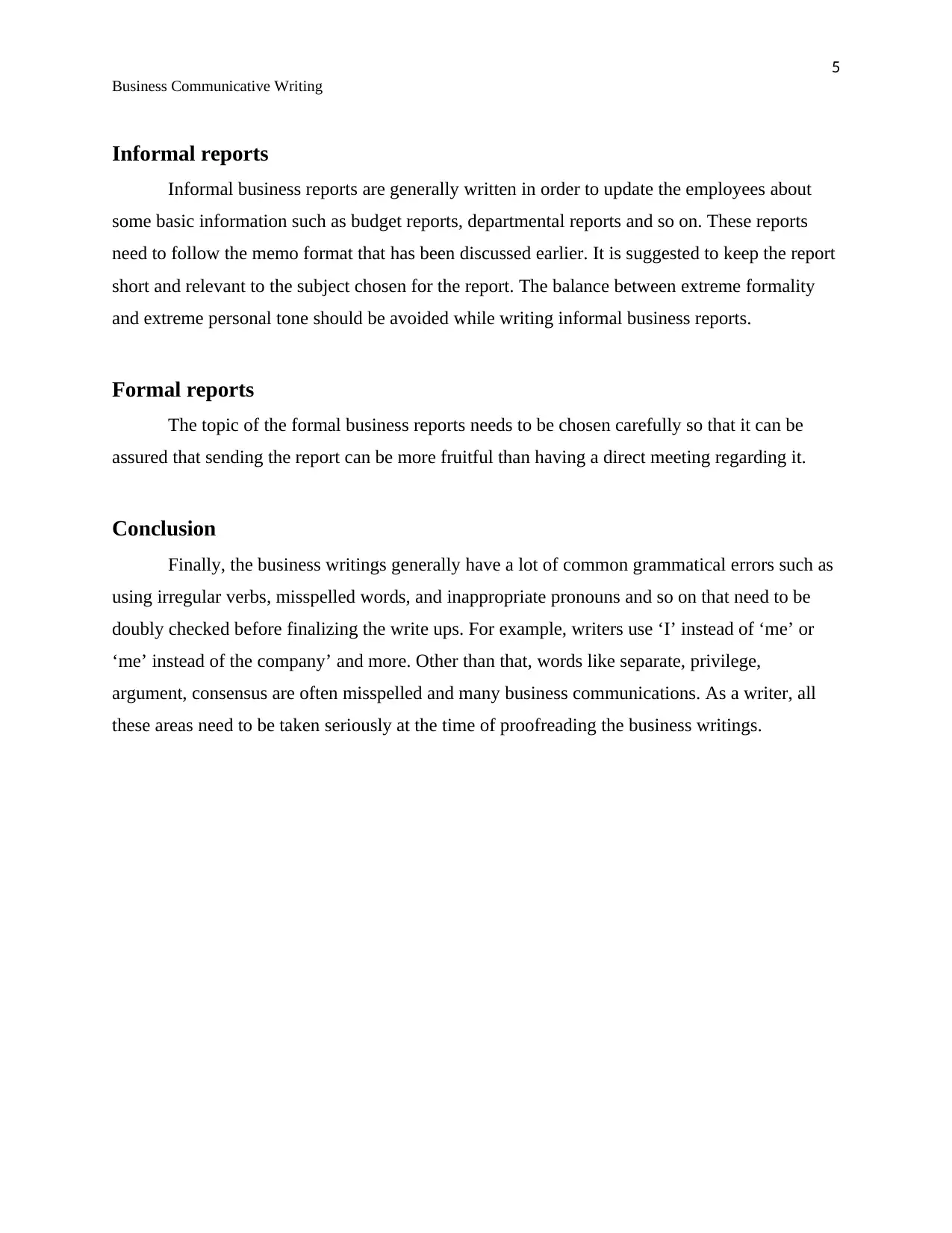
5
Business Communicative Writing
Informal reports
Informal business reports are generally written in order to update the employees about
some basic information such as budget reports, departmental reports and so on. These reports
need to follow the memo format that has been discussed earlier. It is suggested to keep the report
short and relevant to the subject chosen for the report. The balance between extreme formality
and extreme personal tone should be avoided while writing informal business reports.
Formal reports
The topic of the formal business reports needs to be chosen carefully so that it can be
assured that sending the report can be more fruitful than having a direct meeting regarding it.
Conclusion
Finally, the business writings generally have a lot of common grammatical errors such as
using irregular verbs, misspelled words, and inappropriate pronouns and so on that need to be
doubly checked before finalizing the write ups. For example, writers use ‘I’ instead of ‘me’ or
‘me’ instead of the company’ and more. Other than that, words like separate, privilege,
argument, consensus are often misspelled and many business communications. As a writer, all
these areas need to be taken seriously at the time of proofreading the business writings.
Business Communicative Writing
Informal reports
Informal business reports are generally written in order to update the employees about
some basic information such as budget reports, departmental reports and so on. These reports
need to follow the memo format that has been discussed earlier. It is suggested to keep the report
short and relevant to the subject chosen for the report. The balance between extreme formality
and extreme personal tone should be avoided while writing informal business reports.
Formal reports
The topic of the formal business reports needs to be chosen carefully so that it can be
assured that sending the report can be more fruitful than having a direct meeting regarding it.
Conclusion
Finally, the business writings generally have a lot of common grammatical errors such as
using irregular verbs, misspelled words, and inappropriate pronouns and so on that need to be
doubly checked before finalizing the write ups. For example, writers use ‘I’ instead of ‘me’ or
‘me’ instead of the company’ and more. Other than that, words like separate, privilege,
argument, consensus are often misspelled and many business communications. As a writer, all
these areas need to be taken seriously at the time of proofreading the business writings.
⊘ This is a preview!⊘
Do you want full access?
Subscribe today to unlock all pages.

Trusted by 1+ million students worldwide
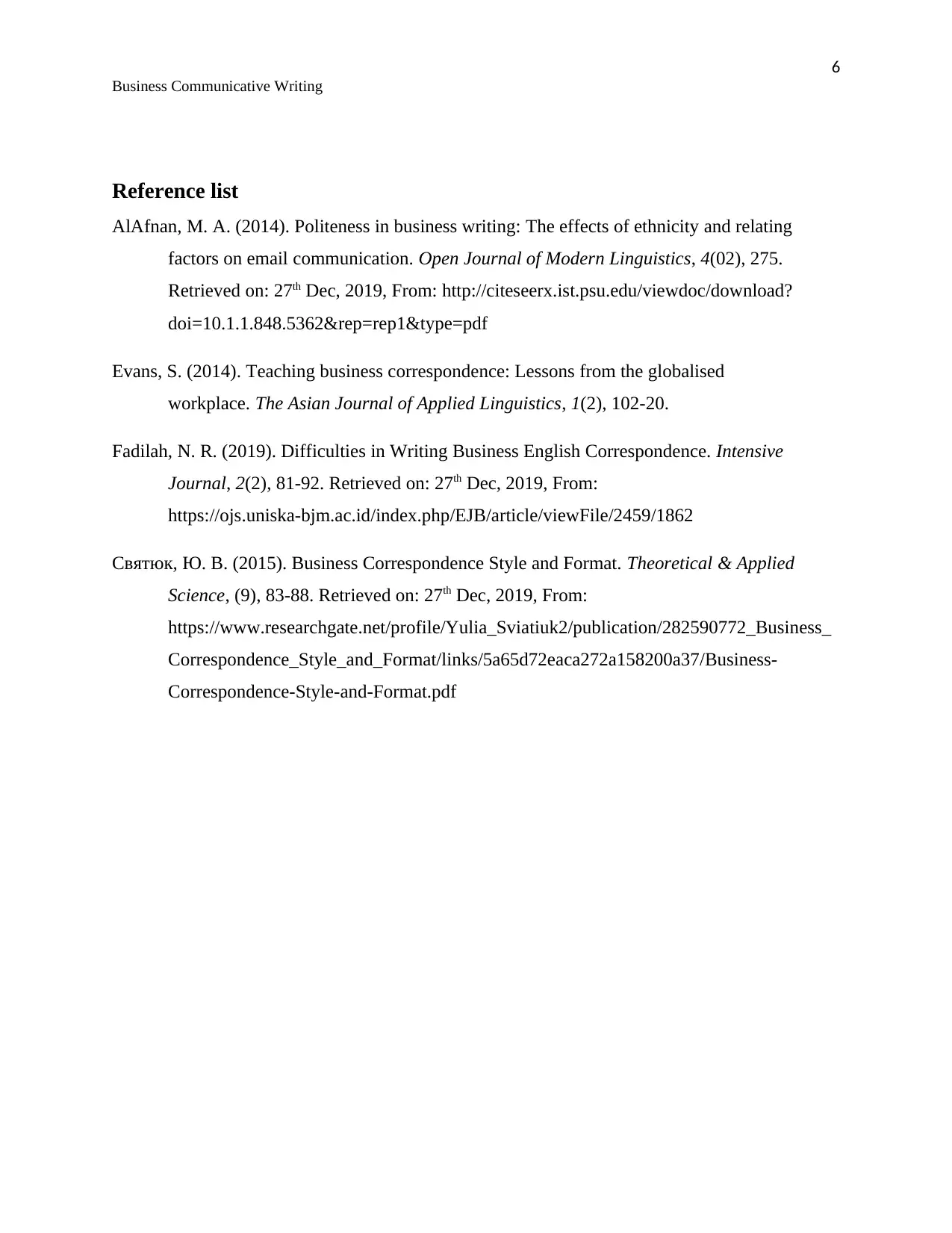
6
Business Communicative Writing
Reference list
AlAfnan, M. A. (2014). Politeness in business writing: The effects of ethnicity and relating
factors on email communication. Open Journal of Modern Linguistics, 4(02), 275.
Retrieved on: 27th Dec, 2019, From: http://citeseerx.ist.psu.edu/viewdoc/download?
doi=10.1.1.848.5362&rep=rep1&type=pdf
Evans, S. (2014). Teaching business correspondence: Lessons from the globalised
workplace. The Asian Journal of Applied Linguistics, 1(2), 102-20.
Fadilah, N. R. (2019). Difficulties in Writing Business English Correspondence. Intensive
Journal, 2(2), 81-92. Retrieved on: 27th Dec, 2019, From:
https://ojs.uniska-bjm.ac.id/index.php/EJB/article/viewFile/2459/1862
Святюк, Ю. В. (2015). Business Correspondence Style and Format. Theoretical & Applied
Science, (9), 83-88. Retrieved on: 27th Dec, 2019, From:
https://www.researchgate.net/profile/Yulia_Sviatiuk2/publication/282590772_Business_
Correspondence_Style_and_Format/links/5a65d72eaca272a158200a37/Business-
Correspondence-Style-and-Format.pdf
Business Communicative Writing
Reference list
AlAfnan, M. A. (2014). Politeness in business writing: The effects of ethnicity and relating
factors on email communication. Open Journal of Modern Linguistics, 4(02), 275.
Retrieved on: 27th Dec, 2019, From: http://citeseerx.ist.psu.edu/viewdoc/download?
doi=10.1.1.848.5362&rep=rep1&type=pdf
Evans, S. (2014). Teaching business correspondence: Lessons from the globalised
workplace. The Asian Journal of Applied Linguistics, 1(2), 102-20.
Fadilah, N. R. (2019). Difficulties in Writing Business English Correspondence. Intensive
Journal, 2(2), 81-92. Retrieved on: 27th Dec, 2019, From:
https://ojs.uniska-bjm.ac.id/index.php/EJB/article/viewFile/2459/1862
Святюк, Ю. В. (2015). Business Correspondence Style and Format. Theoretical & Applied
Science, (9), 83-88. Retrieved on: 27th Dec, 2019, From:
https://www.researchgate.net/profile/Yulia_Sviatiuk2/publication/282590772_Business_
Correspondence_Style_and_Format/links/5a65d72eaca272a158200a37/Business-
Correspondence-Style-and-Format.pdf
1 out of 7
Related Documents
Your All-in-One AI-Powered Toolkit for Academic Success.
+13062052269
info@desklib.com
Available 24*7 on WhatsApp / Email
![[object Object]](/_next/static/media/star-bottom.7253800d.svg)
Unlock your academic potential
Copyright © 2020–2025 A2Z Services. All Rights Reserved. Developed and managed by ZUCOL.




